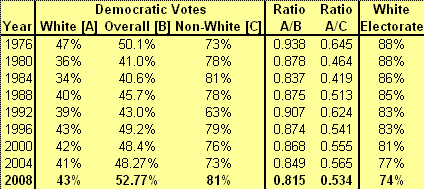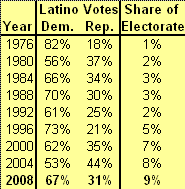Presidential elections are generally followed by hyperbole about the significance of the outcome, and the American fixation on race has exacerbated the phenomenon this year. Now that some weeks have passed, we might look at the sociological implications more soberly.
Campaign rhetoric notwithstanding, it is hardly the case that the United States has moved into a postracial period. Sen. Obama’s base of electoral support came disproportionately from racial minorities, even for a Democrat. In an election where he won 52% of the total vote, Obama claimed only 43% of the white vote. While 43% is as high as any Democratic candidate of the last 30 years, this is misleading since all those other Democrats were either losing tickets or in three-way races, so they naturally had a lower share of the white vote. If we compare each Democrat’s performance among whites with his share of the overall vote, Obama performed most poorly, as shown in the table below.

However, we must also note that the white vote has become a progressively smaller share of the electorate. To control for this, we can instead compare the share of the white vote with the share of the non-white vote. Here again, Obama performs poorly compared with recent Democrats, exceeding only the disastrous campaigns of the 1980s.
The ethnic group that decided this election was not whites, where Obama underperformed relative to the strength of his campaign, or blacks, which historically vote overwhelmingly Democratic no matter what, but the Latinos, who have grown to about 9% of the electorate, from about 2% in 1992. The chart below shows that the inroads Bush had made into the Latino electorate were wiped out in this election. The Republicans can no longer afford to neglect Latino voters, so some of them may have to re-examine their nativist stance on immigration and other issues.

The shift in the Latino vote is likely related more to economic status than immigration reform, as both candidates were moderates on this issue. Latinos and other minorities that voted two-thirds for Obama are disproportianately in lower income brackets. If we break down voting by family income, we find that the election was decided by those making less than $50,000, which is quite low for the U.S. cost of living. Low-income voters, who now constitute a hefty 38% of the electorate, favored Obama over McCain 60% to 38%, while those making over $50K split 49%-49%.
If we look at the middle and higher income brackets in more detail, we find that the brackets between $50K and $200K split about evenly, slightly favoring McCain. Interestingly, those making $200,000 or more favored Obama 52% to 46%. This suggests a defection of the Rockefeller Republicans, meaning that the GOP, momentarily at least, are not the party of the rich, but have their base in the middle class. It would be wise for them to build on this strength rather than appease the high-income crowd, who constitute only 6% of the electorate, at the expense of the middle class.
Contrary to post-election hyperbole, this election does not indicate a sharp ideological turn toward liberalism. Only 22% of voters self-identify as liberal, compared with 34% who call themselves conservatives. Ironically, the racial minorities who vaulted the Democrats to victory also made possible the defeat of same-sex marriage in California. As the Democrats become increasingly dependent on ethnic minorities for election victories, they may have to respect the social traditionalism of these groups.
In light of these facts, it would be foolish for the Republicans, or indeed any political party that loses an election 52% to 46%, to completely reinvent itself ideologically. Such hysterical overreaction is what doomed the McCain campaign, which was constantly looking for game-changers like the desperate Palin pick. Political success comes through real work, starting with learning the concerns of one’s constituents – which this year were principally economic – and by reaching out and engaging them. Perhaps the most telling statistic regarding the differing energy levels of the campaigns is that the Obama campaign personally contacted 26% of voters, while McCain’s volunteers contacted only 19%.
Now that “change” is upon us, reality will soon set in. Contrary to rhetoric by both campaigns, Obama is a moderate on economic and foreign policy, and this is already being reflected in his cabinet selections. Obama will likely give us more of the same Israeli-leaning policy on Palestine, if his chief of staff Rahm Emmanuel, a hard-line Zionist, is any indication. His choice of Hillary Clinton as Secretary of State is perplexing, considering the only substantial difference between Clinton and Obama is on foreign policy. While it is possible that Obama is trying to patch up rifts with the Clintonites, it is more likely that these appointments reflect his own policy preferences, which, for the most part, are unremarkable Democratic boilerplate. Still, though his ideas are unoriginal, Obama appears to be a genuinely thoughtful man, so the possibility of surprise remains.
Sources
2008 national exit polls
1976-2004 election results by demographic